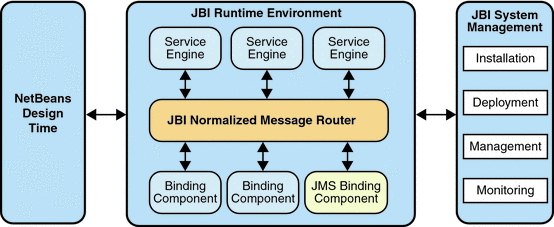JMS Binding Component Overview
The JMS Binding Component includes NetBeans design-time components and a Java Business Integration (JBI) runtime.
The design-time component is a NetBeans module that plugs into the NetBeans project system. The runtime portion provides interfaces for accepting messages from the JBI runtime, or using interfaces provided by JBI for communicating with the JBI runtime.
The flexible and extensible architecture of JBI enables components such as the JMS Binding Component to use a messaging model that separates service consumers from service providers. This messaging model is defined using Web Services Description Language (WSDL), which describes the operations exposed by the binding component. WSDL is also used to define transport-level bindings for the abstract service operations. During design time, you configure the JMS Binding Component by using the JMS WSDL extensibility elements.
The JBI specification also includes a model that describes the exchange of messages between message consumers and message providers.
In an outbound message flow, the JMS Binding Component acts as a service provider. The JMS Binding Component receives a normalized message from the Normalized Message Router (NMR), converts that message to a JMS message, and then sends the message to a JMS destination.
In an inbound message flow, the JMS Binding Component acts as a proxy consumer. The JMS Binding Component converts the JMS message that it receives from a JMS service to a normalized message, and then sends the normalized message as part of the message exchange to another component as a service request.
The following diagram illustrates the relationship between the JMS Binding Component in the JBI Runtime Environment, the design-time (NetBeans) and other JBI system management components.

- © 2010, Oracle Corporation and/or its affiliates
